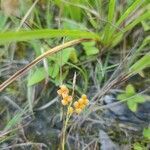Culms 5–40 cm. Leaves: blades 3–20(–30) cm × 1.4–3 mm. Inflorescences: proximal bracts with well-developed blades exceeding inflorescence sheaths 2–4(–10) mm; lateral spikes with 4–20 perigynia, approximate or proximal distant, lax, 4–20(–30) × 3–5 mm, middle internodes (0.5–)0.7–1.5 mm; terminal spike usually staminate, occasionally gynecandrous, sessile or short-pedunculate, 3–10(–15) × 0.9–2 mm. Pistillate scales brown with paler or green midvein, divergent in mature fruit, ovate to ovate-circular, 1.2–2.5 × 1.1–1.8 mm, apex subacute to obtuse or cuspidate. Proximal staminate scales brown with paler or green midvein and hyaline margins, oblong-ovate, 2–3.5(–4) mm, apex obtuse to subacute. Perigynia divergent, bright orange, somewhat inflated and fleshy when mature, circular-obovate, 2.3–3.2 × 1.2–1.8 mm, smooth or minutely papillose. Achenes subcircular, 1.4–1.8 × 1–1.5 mm. 2n = 52.

